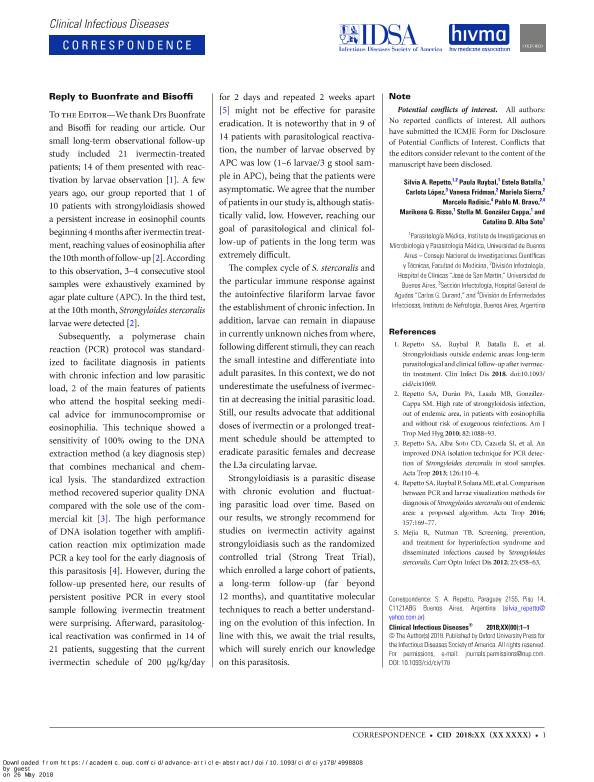Artículo
Reply to Buonfrate and Bisoffi
Repetto, Silvia A; Ruybal, Paula ; Batalla, Estela
; Batalla, Estela ; López, Carlota; Fridman, Vanesa; Sierra, Mariela; Radisic, Marcelo; Bravo, Pablo M.; Risso, Marikena Guadalupe
; López, Carlota; Fridman, Vanesa; Sierra, Mariela; Radisic, Marcelo; Bravo, Pablo M.; Risso, Marikena Guadalupe ; González, Stella Maris
; González, Stella Maris ; Alba Soto, Catalina Dirney
; Alba Soto, Catalina Dirney
 ; Batalla, Estela
; Batalla, Estela ; López, Carlota; Fridman, Vanesa; Sierra, Mariela; Radisic, Marcelo; Bravo, Pablo M.; Risso, Marikena Guadalupe
; López, Carlota; Fridman, Vanesa; Sierra, Mariela; Radisic, Marcelo; Bravo, Pablo M.; Risso, Marikena Guadalupe ; González, Stella Maris
; González, Stella Maris ; Alba Soto, Catalina Dirney
; Alba Soto, Catalina Dirney
Fecha de publicación:
08/2018
Editorial:
University of Chicago Press
Revista:
Clinical Infectious Diseases
ISSN:
1058-4838
e-ISSN:
1537-6591
Idioma:
Inglés
Tipo de recurso:
Artículo publicado
Clasificación temática:
Resumen
To the Editor ? We thank Drs Buonfrate and Bisof for reading our article. Our small long-term observational follow-up study included 21 ivermectin-treated patients; 14 of them presented with reactivation by larvae observation [1]. A few years ago, our group reported that 1 of 10 patients with strongyloidiasis showed a persistent increase in eosinophil counts beginning 4 months afer ivermectin treatment, reaching values of eosinophilia afer the 10th month of follow-up [2]. According to this observation, 3?4 consecutive stool samples were exhaustively examined by agar plate culture (APC). In the third test, at the 10th month, Strongyloides stercoralis larvae were detected [2]. Subsequently, a polymerase chain reaction (PCR) protocol was standardized to facilitate diagnosis in patients with chronic infection and low parasitic load, 2 of the main features of patients who attend the hospital seeking medical advice for immunocompromise or eosinophilia. Tis technique showed a sensitivity of 100% owing to the DNA extraction method (a key diagnosis step) that combines mechanical and chemical lysis. Te standardized extraction method recovered superior quality DNA compared with the sole use of the commercial kit [3]. Te high performance of DNA isolation together with amplifcation reaction mix optimization made PCR a key tool for the early diagnosis of this parasitosis [4]. However, during the follow-up presented here, our results of persistent positive PCR in every stool sample following ivermectin treatment were surprising. Aferward, parasitological reactivation was confrmed in 14 of 21 patients, suggesting that the current ivermectin schedule of 200 μg/kg/day for 2 days and repeated 2 weeks apart [5] might not be effective for parasite eradication. It is noteworthy that in 9 of 14 patients with parasitological reactivation, the number of larvae observed by APC was low (1?6 larvae/3 g stool sample in APC), being that the patients were asymptomatic. We agree that the number of patients in our study is, although statistically valid, low. However, reaching our goal of parasitological and clinical follow-up of patients in the long term was extremely difcult. Te complex cycle of S. stercoralis and the particular immune response against the autoinfective flariform larvae favor the establishment of chronic infection. In addition, larvae can remain in diapause in currently unknown niches from where, following different stimuli, they can reach the small intestine and differentiate into adult parasites. In this context, we do not underestimate the usefulness of ivermectin at decreasing the initial parasitic load. Still, our results advocate that additional doses of ivermectin or a prolonged treatment schedule should be attempted to eradicate parasitic females and decrease the L3a circulating larvae. Strongyloidiasis is a parasitic disease with chronic evolution and fluctuating parasitic load over time. Based on our results, we strongly recommend for studies on ivermectin activity against strongyloidiasis such as the randomized controlled trial (Strong Treat Trial), which enrolled a large cohort of patients, a long-term follow-up (far beyond 12 months), and quantitative molecular techniques to reach a better understanding on the evolution of this infection. In line with this, we await the trial results, which will surely enrich our knowledge on this parasitosis.
Archivos asociados
Licencia
Identificadores
Colecciones
Articulos(IMPAM)
Articulos de INSTITUTO DE INVESTIGACIONES EN MICROBIOLOGIA Y PARASITOLOGIA MEDICA
Articulos de INSTITUTO DE INVESTIGACIONES EN MICROBIOLOGIA Y PARASITOLOGIA MEDICA
Citación
Repetto, Silvia A; Ruybal, Paula; Batalla, Estela; López, Carlota; Fridman, Vanesa; et al.; Reply to Buonfrate and Bisoffi; University of Chicago Press; Clinical Infectious Diseases; 67; 5; 8-2018; 811-812
Compartir
Altmétricas



